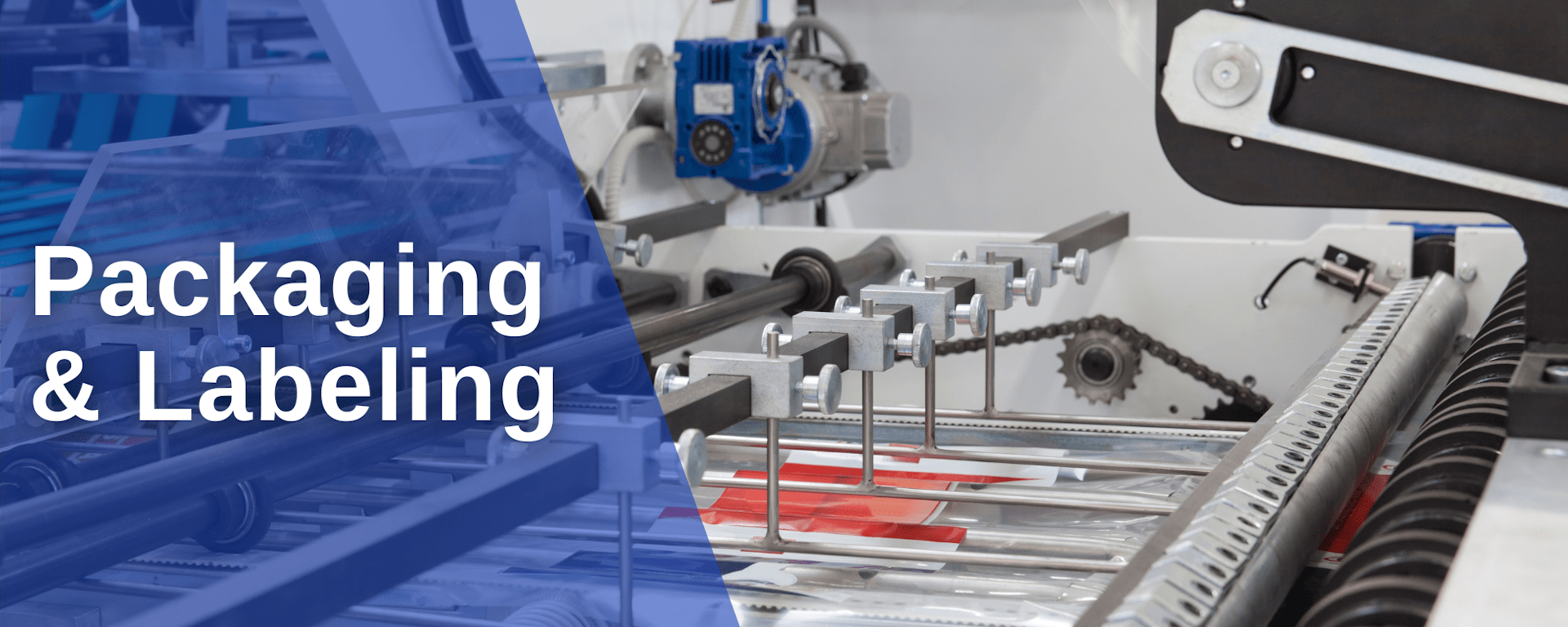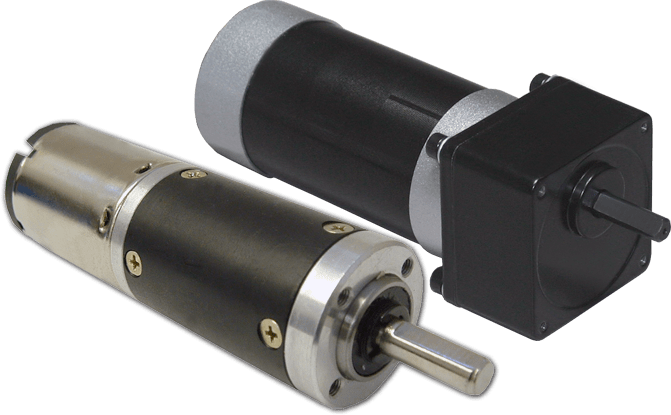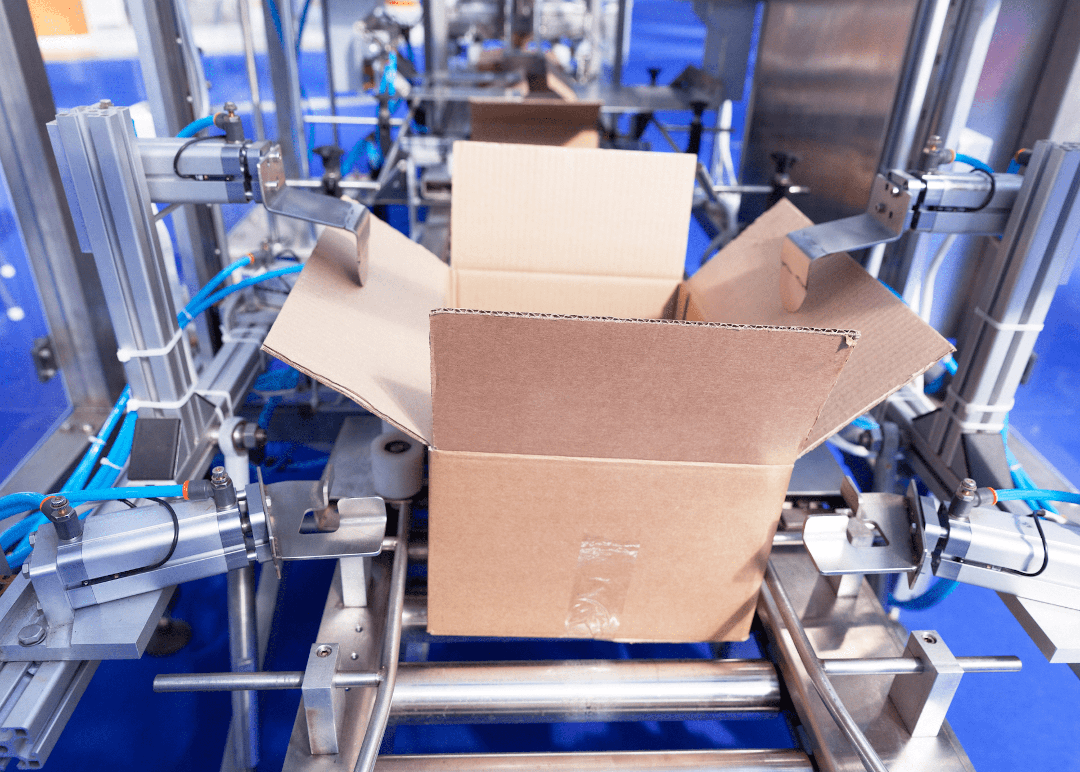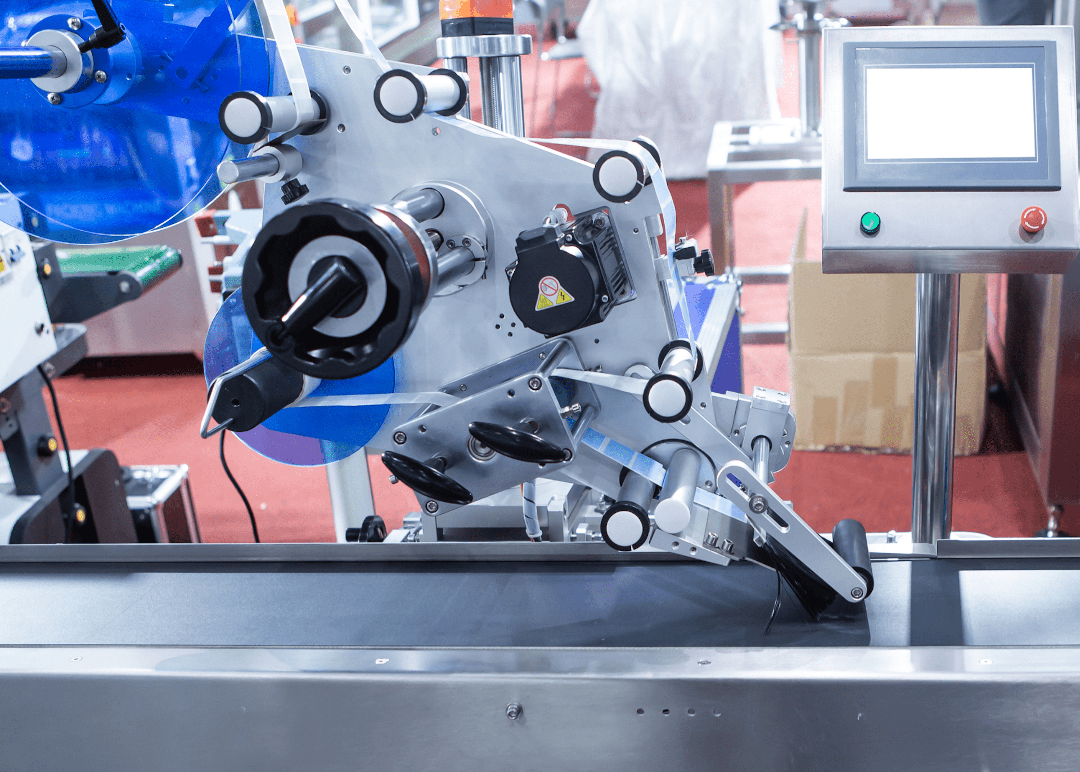We use cookies to make your experience better. To comply with the new e-Privacy directive, we need to ask for your consent to set the cookies. Learn more.

Packaging and Labeling
Automated packaging and labeling machinery has revolutionized the way products are packaged. Automated equipment allows for efficient packing, labeling, and sealing of a wide variety of items in industries from agriculture to distribution to retail. The top benefit of automated packaging equipment includes increased speed, efficiency, and accuracy when compared with manual methods, thereby reducing the possibility of errors and increasing production capacity. Automating the packaging and labeling process allows companies to produce more products in a shorter amount of time.
For over 50 years, Anaheim Automation, Inc. has provided a wide variety of motion control products to OEM customers who serve the packaging and labeling industries. Applications may include wind-up reels and tensioners, shrink-wrap and blister-pack machines, labeling, cartoning, case-packing, and tamping-evident sleeving, pouching, sealing, and more. A very popular application in this category is labeling machinery. Labeling systems are used to apply labels to individual items, such as bottles and jars, as well as the outer carton for shipping. Anaheim Automation provides cost-effective solutions for the packaging/labeling industry, including stepper, servo, and brushless DC motors and drives, as well as gearboxes, gearmotors, PLCs and HMIs.
Anaheim Automation's vast experience with OEM customers in the packaging and labeling industries allows the company to understand the unique requirements for each OEM's end-products, namely: precision, repeatability, footprint limitations, efficiency, quiet/smooth operation, and environmental considerations. Anaheim Automation is instrumental in the research and development phase for OEMs, in that they provide smaller quantities for proof-of-concept and testing. Anaheim Automation understands that timeliness in response to technical questions and concerns in the R&D phase, and the ability to customize components to exact requirements, are critical to the success of its customers in the packaging and labeling industries, among others.
The most popular products for the packaging industry in general are Stepper Motors and Drivers, BLDC and Servo Motors and Drives, Linear Guides, Ball Screws, Gearmotors, Gearboxes, PLCs and HMIs (Human Machine Interfaces). Stepper, BLDC, and Servo products are most frequently used, and they are often purchased along with value-added components such as encoders, mechanical brakes, cables and connectors, and gearboxes. Also available are Integrated Stepper and Servo motors, in which motor and drive, or motor/drive/controller, are integrated into one complete package.
Products for Packaging & Labeling Automation
Stepper
Due to their accurate positioning and reliable performance, stepper products are frequently used in packaging and labeling equipment. Stepper motors can provide a wide range of motion speeds, from very slow to very fast, allowing for precise and efficient product packaging and labeling. Steppers can also be used to precisely position labels and products, ensuring accuracy and uniformity in the packaging and labeling process. Additionally, stepper motors and drivers are highly energy efficient and require minimal maintenance, making them an ideal choice for use in busy production lines.

Anaheim Automation 34Y Stepper Motor and MLA10641 Microstep Driver
Anaheim Automation offers Stepper Motors in NEMA sizes 08 – 42, with NEMA sizes 23 and 34 being the most popular sizes used in the packaging industry. Customers can choose from a wide variety of torque ratings and features available in standard off-the-shelf stepper motors, making the R&D process fast and simple. Stepper Motors with Integrated Drivers, or Stepper Motors with Integrated Drivers and Controllers, are also available in NEMA 23 and NEMA 34 frame sizes.
Stepper Gearmotors are also an excellent solution for a variety of packaging and labeling applications, frequently used in case packaging machines, filling, gluing, sealing, and conveyor systems. Anaheim Automation's line of stepper gearmotors offers both hybrid and permanent magnet stepper motors combined with either a planetary or spur gearbox to create a single cost-effective unit. Each stepper gearmotor is available in a broad range of gear ratios to provide the appropriate torque for a given application.
In addition to its standard products, Anaheim Automation motors can be customized to include an encoder, brake, gearbox, and/or cable and connector, even at small quantities. Further customizations – such as shaft modifications, special windings, or private-labeling – are also available. Some customizations may require a MOQ (Minimum Order Quantity).
Servo
Servo motors and servo drives can be used anywhere a stepper motor would be used. The open-loop nature of stepper systems requires that they be proactively protected against physical disturbances in order to prevent stalling. Servos, however, operate on a closed-loop system, meaning they receive feedback from an internal encoder with every encoder pulse. This means that if a servo motor stalls, the user will know exactly where the stall occurred. In this way, a servo system can be more efficient with lower-maintenance requirements and quieter operation.

Servo Motor and Driver
Servo motors and drives provide precise control over the speed, position, and torque of the machine's moving parts, allowing for the accurate and efficient packaging and labeling of products. For example, servos can be used to control the speed of a conveyor belt which transports products to be labeled and packaged, ensuring that the product is properly aligned and positioned. A servo drive can precisely control the torque of the machine to ensure that the packaging or labeling material is applied accurately and securely. This increased accuracy helps to reduce defects and waste, making servo products an invaluable part of any automated packaging and labeling equipment.
Anaheim Automation offers servo motors ranging from 50 to 5,000 Watts, in frame sizes from 40 to 180mm. Customers can choose from individual motor, drive, and cable components, or opt for one of Anaheim Automation's integrated servo motor/drive units or complete servo systems. Anaheim Automation is known for our well-priced servo systems, bringing the machinery cost down while increasing convenience and overall performance.
Planetary Gearboxes
Planetary gearboxes are an incredibly useful means of transmitting mechanical power. They are often used in automated packaging and labeling machinery as they offer a reliable and powerful solution for precise and efficient motion control. This type of gearbox has many advantages, including high gear ratios, compact size, high torque capacity, and the ability to accommodate a wide range of speeds.

Anaheim Automation Planetary Gearboxes
One of the primary advantages of planetary gearboxes is their compact design. They are able to transmit a high amount of torque while also taking up a relatively small amount of space, making them ideal for applications where space is limited. Another benefit of planetary gearboxes is their efficiency. These gearboxes can reach high levels of efficiency, often over 90%, meaning that they are able to generate more power with less energy. This can help to reduce energy costs and increase the efficiency of a system overall.
Planetary gearboxes are also highly reliable. They are able to operate in a variety of environments, and their robust construction and design allow them to withstand high amounts of stress and pressure. This makes them an ideal choice for applications where reliability is essential.
Finally, planetary gearboxes are relatively easy to maintain. With their enclosed design and relatively few moving parts, these gearboxes are easily serviced and maintained without the need for any specialized tools or equipment. Anaheim Automation can also mount the gearbox to the motor for a nominal charge.
Anaheim Automation's planetary gearboxes are compatible with most of its stepper, servo, and brushless motors. Gearboxes can also be customized to mount to specified motor dimensions. Further customization – such as shaft modifications or private-labeling – is also available, but may require an MOQ (Minimum Order Quantity).
Brush DC and BLDC Gearmotors
Brush DC gearmotors are electric gearmotors that use small brushes to transfer electricity to the rotor to create motion. This type of gearmotor is often used in small, low-cost applications and is relatively easy to install and maintain, though the brushes do wear down over time. Brushless DC gearmotors, on the other hand, have no brushes, are more efficient, and require less maintenance than their brush DC counterparts. BLDC gearmotors use internal permanent magnets to create motion, resulting in higher speeds, greater torque, and less heat output.

Brush DC and Brushless DC (BLDC) Gearmotors
In automated packaging and labeling applications, both Brush DC and BLDC gearmotors can be used in a variety of ways, for example: to drive conveyor belts which move products through the system, in the labeling heads that apply labels to products, in the rotary cutters that cut labels, and the stamping heads that apply stamps to boxes or containers. The type of motor used will depend on the specific application and desired performance results. Both types are reliable, efficient, and low-maintenance. In general, the pricier BLDC gearmotors will run more quietly than brush gearmotors. Anaheim Automation offers a selection of planetary, spur, and worm gear style BLDC and brush DC gearmotors.
In addition to our standard products, Anaheim Automation brush DC and brushless DC gearmotors can have encoders, cables, connectors, and other value-added components added, even in small quantities. Further customization – such as shaft modifications, special windings, or private-labeling – are also available, but may require an MOQ (Minimum Order Quantity).
HMI (Human Machine Interface) and PLC (Programmable Logic Controllers)
Human Machine Interfaces (HMIs), also referred to as Industrial Touch Screens, are vital components in automated packaging and labeling equipment. The use of HMIs in packaging and labeling machinery provides numerous advantages, such as reducing the risk of manual errors, improving efficiency and productivity, and reducing system downtime. HMIs provide a user-friendly interface between the machine and the operator, allowing users to easily control and monitor every aspect of the system from a single access point. By providing the operator with real-time information and control, HMIs enable better decision-making, improved performance, and greater efficiency. This data can also be used to identify areas for improvement in production optimization, allowing manufacturers to take corrective action.

HMIs and PLCs
Anaheim Automation HMIs are able to communicate with our PLCs (Programmable Logic Controllers), as well as PLCs from different manufacturers. Also available and gaining popularity is our line of integrated HMI/PLC combination units, to provide users with even greater convenience and efficiency. The 4.3" KNC-HMI-MK043E-20DT and the 7" KNC-HMI-MK070E-33DT cut down on cost, development time, and space while still providing all of the features of non-integrated units.
Anaheim Automation's broad line of HMIs is one of the most cost-effective options in the field of motion control. Its HMI touchscreens, available with display sizes from 4.3 inches to 15 inches, allow users to easily control their entire system from a single centralized location. In addition to standard models, "blank" (unbranded – no logo) models are available, so customers can customize the start-up screen to display their logo and/or company name. The most popular models include the 4.3" KNC-HMI-GL043, the 7" KNC-HMI-GL070E, and the 10.1" KNC-HMI-GL100E.
Common Applications
Packaging Machine

Automated packaging machines are a great way to increase efficiency and reduce costs in the packaging process. They are able to quickly and accurately package items, often with minimal human intervention or contamination. Packaging machines are capable of handling a wide variety of products, from small items such as jewelry to large items such as furniture. They can be customized to meet specific packaging requirements, including size, shape, and type of packaging material. Overall operation costs may be reduced due to the lack of personnel needed to oversee the packaging process, as well as the reduction in material waste per packaged item because of the increased accuracy.
Products for Packaging Machines
Stepper Motors and Drivers
Stepper motors are commonly used in packaging machines due to their precise and accurate positioning control. Steppers are able to provide a high degree of accuracy and can be programmed to move a specific number of steps, thus providing the exact amount of motion necessary to position the item. Step motors are also relatively simple to operate and can be easily interfaced with a variety of controllers or drivers. Furthermore, stepper motors are highly reliable and require minimal maintenance, as well as being relatively inexpensive, making them an ideal and economical choice for packaging machines.
Planetary Gearboxes
Planetary gearboxes are an excellent option for use in automated packaging equipment due to their robust design, high power density, and reliable performance. They are able to operate with minimal noise and vibration and handle high-torque loads at high speeds.
Brush DC Gearmotors
Due to their ability to deliver reliable and consistent performance, as well as their compact size, brush DC gearmotors are frequently used in packaging machines. They can be used to drive various parts of the packaging system, such as conveyor belts, rollers, and indexers. DC gearmotors are designed to provide high torque at low speeds, making them ideal for applications requiring precision and delicate control. Additionally, they are also capable of delivering reliable and long-lasting performance at a relatively low cost.
Labeling Machines

Automated labeling machines provide accuracy and speed in the labeling of items with logos, text, barcodes, or graphics quickly and efficiently, even on curved or irregularly shaped surfaces. These machines can be used in a wide range of industries, such as food and beverage, consumer goods, and pharmaceuticals. Labeling machines provide a much higher accuracy level than manual labeling, eliminating the need for manual inspection and reworks, thereby drastically reducing costs.
Products for Labeling Machines
Servo Motors and Drives
Servo motors are able to move at high speeds and accurately rotate to precise positions, making them ideal for labeling applications. They can be programmed to perform complex tasks with exact accuracy, allowing labels to be placed with precision. Servo motors also have a high torque-to-inertia ratio, which allows them to operate quickly and powerfully, making them well-suited for high-speed labeling. Additionally, servo motors require minimal maintenance and can be easily integrated into existing automated systems.
HMIs and PLCs
HMIs provide a simple, user-friendly interface that allows operators to easily view and modify settings, as well as monitor the machine's performance. PLCs, on the other hand, are reliable and powerful controllers that can be programmed to control the labeling machine's movements, speed, and other processes to ensure accuracy, repeatability, and reliability. In addition, PLCs have the ability to store and recall data, allowing for more efficient system operation.
Ball Screws
Ball screws are commonly used in automated labeling machines due to their high accuracy, low friction, and high torque capabilities. Ball screws help to ensure that labels are precisely placed according to the programmed requirements. They are typically composed of a threaded shaft and a series of rolling elements (usually ball bearings) which help to reduce the friction between the screw and the nut, resulting in smoother, faster operation. Additionally, ball screws are able to generate high torques with minimal effort, making them ideal for pushing labels onto products. Furthermore, they are highly durable and are able to withstand the high speeds and vibrations that labeling machines may encounter during operation. This helps to ensure that the labeling equipment runs smoothly and efficiently.
Autonomous Warehouse Robots

Autonomous warehouse robots are a revolutionary technology that has transformed how warehouses and distribution centers operate. They are designed to move materials from one point to another, picking up and delivering items in the most efficient manner possible. They can work independently or in collaboration with human workers, helping to speed up warehouse operations. Autonomous robots can be programmed to recognize items, remember routes, and even communicate with other robots and human workers. This technology has the potential to reduce labor costs, increase accuracy and productivity, and improve safety in the warehouse. By using autonomous robots, warehouse managers can better manage overall warehouse operations.
Products for Warehouse Robots
BLDC Gearmotors
Brushless DC gearmotors offer several advantages over traditional brush DC motors, including higher power and efficiency. This is especially important for autonomous warehouse robots, which rely on fast and accurate movement in order to perform their tasks. They also offer excellent torque control, allowing for greater precision in the operation of warehouse robots. Additionally, BLDC gearmotors have a long life expectancy and require little maintenance, lessening system downtime and making them a cost-effective choice for this type of application.
Encoders
Encoders are a critical component of autonomous warehouse robots because they enable the robot to accurately measure its movements and control the speed and direction of its motors. Encoders provide the robot with feedback on how far it has traveled in a particular direction, and how fast it is moving. This feedback is used to adjust the robot's speed and direction, enabling it to complete its tasks with precision. Encoders also allow the robot to detect changes in the environment, such as obstacles or changes in terrain, and adjust its course accordingly. This helps the robot to navigate around obstacles and maintain navigational accuracy.
